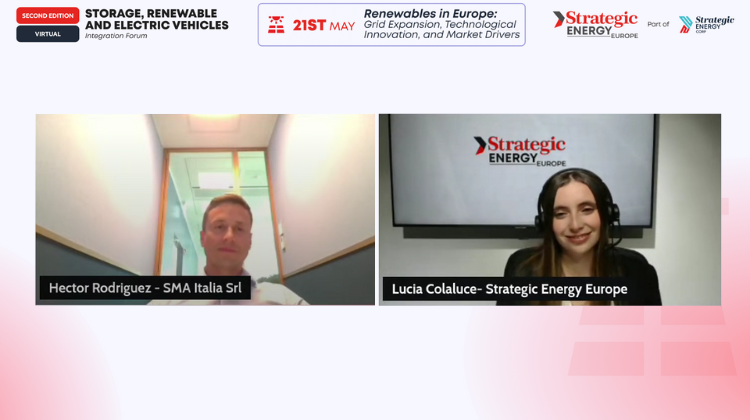Grid stability in Europe lies at the heart of the energy transition debate, and SMA Solar is positioning itself as a key player with a solid technological proposal based on grid forming and large-scale storage.
Héctor Andrés Rodríguez Garnica, PV Market Manager – SEU Region at SMA Solar, highlighted during the second panel of the Storage, Renewable and Electric Vehicles Integration Forum – Second Edition that “grid forming is very important in order to allow the penetration of the massive introduction of inverter-based resources into the interconnected system”.
The second event of the year by Strategic Energy Corp was a two-part virtual session, co-organised with Mobility Portal Europe and Strategic Energy Europe.
Strategic Energy Corp, in partnership with Future Energy Summit (FES), hosts major renewable energy gatherings, as FES stands as the leading platform for renewable energy dialogue in Spanish-speaking countries. Notably, on 24 June, the third edition of FES Iberia 2025 will take place at Colegio Caminos (Auditorio Betancourt, C. de Almagro, 42, Chamberí) in Madrid. (Relive the previous edition here.)
From SMA Solar’s perspective, innovation, regulation, and new business models must operate in synergy for Europe to cement its leadership in solar energy. “The key to Europe’s success will depend on coordinated synergy among these key drivers: innovation, regulation, and business model,” Rodríguez Garnica stresses.
Blackhillock: a flagship project with environmental and economic impact
One of the highlights of his intervention was the Blackhillock project in Scotland, which stands as one of Europe’s largest grid-connected storage installations. “It was the first battery energy storage system in the world connected to the transmission system that is providing stability services to the grid,” he explains.
SMA Solar supplied medium-voltage power stations and inverters operating under a grid-forming control strategy, delivering 370 megawatt-seconds of inertia and 116 megavolt-amperes of short-circuit level.
According to the executive, this contributes not only to a more stable grid but also to reduced CO₂ emissions and lower local energy costs, allowing consumers to “save over 170 million pounds across 15 years”.
Cutting-edge technology for the utility-scale segment
Beyond the Scottish case, the German company with more than 40 years of experience is introducing a new generation of central inverters using silicon carbide (SiC) – a major step forward from traditional silicon IGBT-based solutions.
Rodríguez Garnica notes that “this technology will enable high performance and a stable response to very demanding transient grid conditions”. The goal is to meet the increasing demands for stability services in grids progressively dominated by renewables.
“Grid services will be vital for the full deployment and integration of renewable energy technologies,” he adds.
Regulation and industrial coordination as foundational pillars
He also emphasises that regulation is an essential pillar to ensure the orderly deployment of these disruptive technologies. “Innovation must be implemented in an orderly and responsible way, and this is ensured thanks to regulation,” he states, highlighting the frameworks provided by the Green Deal, the EU Industry Act, and related sustainability directives.
Nonetheless, challenges remain: “We are still waiting for the official release of the new grid code that will introduce new requirements for generators in terms of reforming and stability services.”
Finally, he points to the role of industrial alliances: “There are currently several associations at both European and national levels that bring together manufacturers, grid operators, developers, and users to help establish a unified and robust development of solar in the region.”
Firm commitments to responsible and sustainable development
SMA Solar’s message is clear: Europe must back advanced technological solutions, supported by strong regulation and strategic alliances, to scale up electrification in a safe, efficient, and sustainable manner.
“We must consider the impact of production on the resources we use and ensure a responsible and sustainable development of our solutions,” Rodríguez Garnica concludes.






























